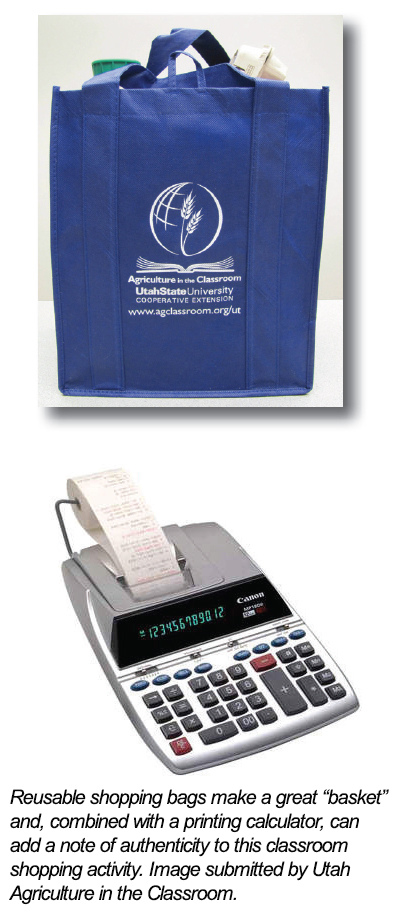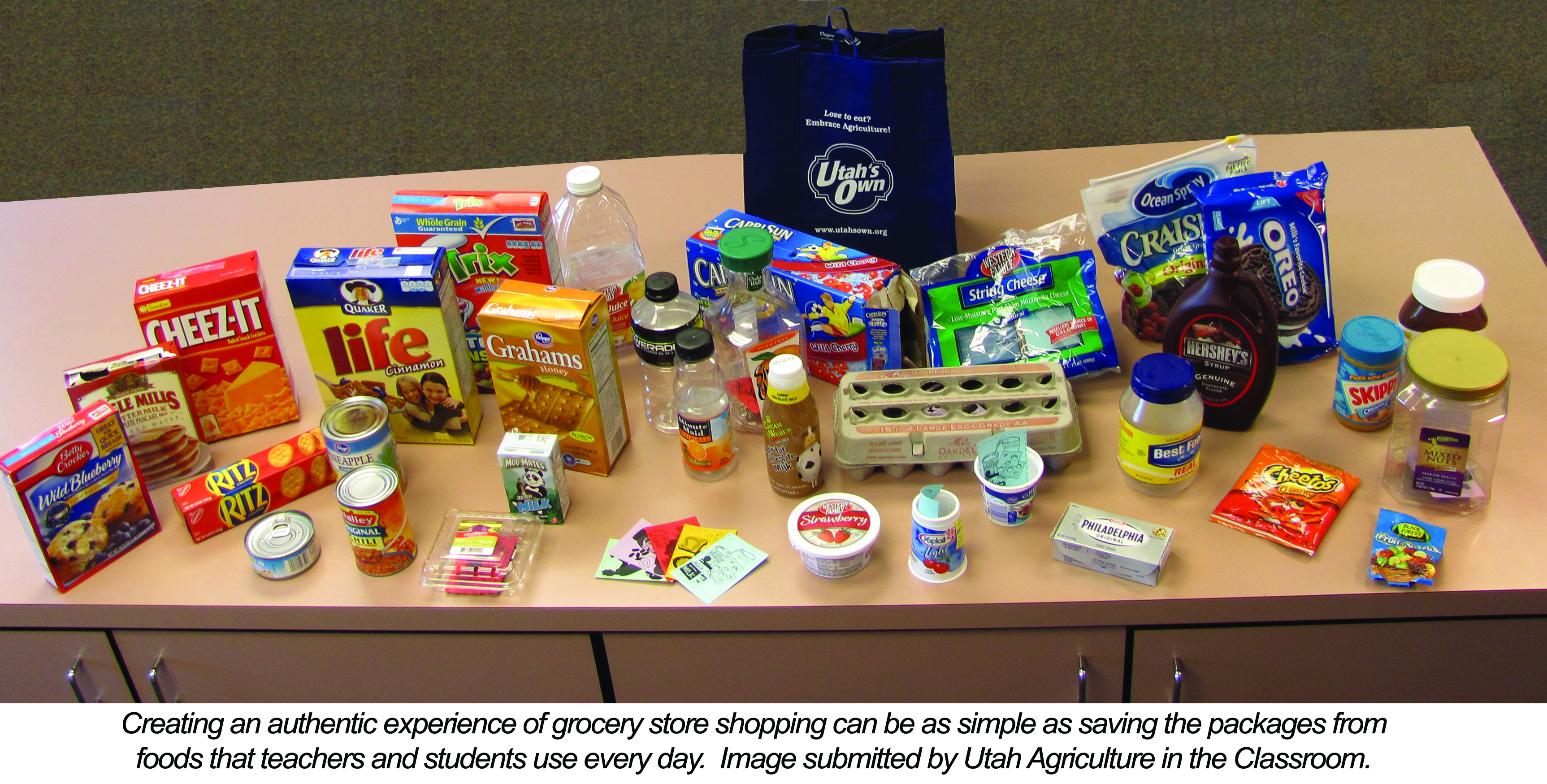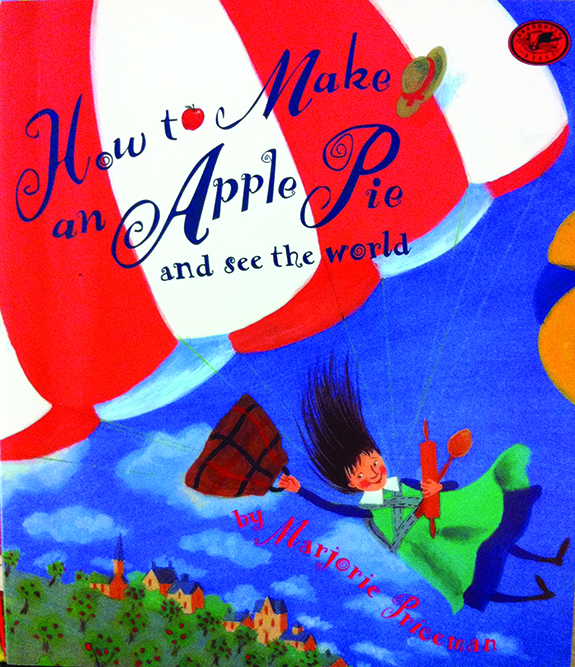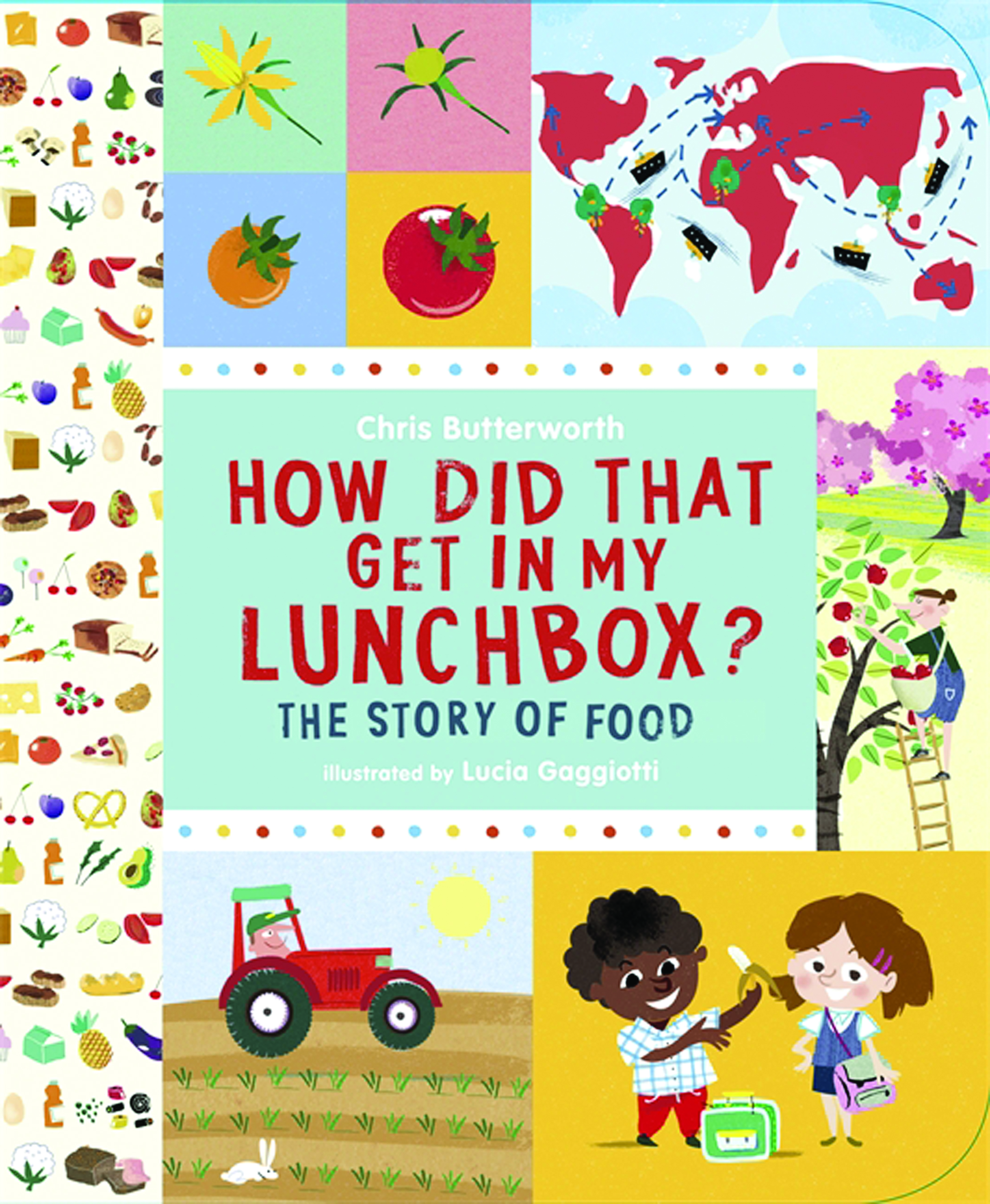Agricultural Literacy Curriculum Matrix
Lesson Plan
Let's Go Shopping! (Grades K-2)
Grade Level
Purpose
Students identify the differences between needs and wants, goods and services, and producers and consumers by participating in a grocery store simulation, exploring the source of grocery store items, and designing their own products to sell. Grades K-2
Estimated Time
Materials Needed
Engage:
 Empty food containers of a variety of different items that students recognize; at least 2 items per student
Empty food containers of a variety of different items that students recognize; at least 2 items per student - Copies of MyPlate Goods and Services Image, cut apart
- Blank stickers to create price tags
- Reusable shopping bags, 1 per group of 5 students
- Play money, $25-$50 per group of 5 students
- Printing calculator (optional)
Activity 1: Understanding Grocery Shopping
- MyPlate Goods and Services Image for display
Activity 2: How Did That Get in the Grocery Store?
- How Did That Get in My Lunchbox by Chris Butterworth and/or How to Make an Apple Pie and See the World by Marjorie Priceman
- Dress-up items (optional)
Activity 3: Invention
- Art paper
- Crayons, markers, colored pencils
Vocabulary
consumer: a person who buys and uses goods and services
good: a physical item that can be held in the hand (e.g., toys, food, electronics)
need: a good or service that is essential to the health and well-being of a person
producer: a person or company that makes, grows, or supplies goods or services
service: transaction in which no physical goods are transferred from the seller to the buyer; non-physical, intangible parts of an economy
want: a good or service that a person would like to buy or have, but that is not essential to their health or well-being
Did You Know?
- More than 21 million American workers (15 percent of the total US workforce) produce, process and sell the nation’s food and fiber.1
- Farm and ranch families make up just 2 percent of the US population.1
Background Agricultural Connections
Toys, clothes, video games, televisions, candy, computers, phones, food... there are so many things to spend money on! When children understand the difference between a need and a want, they will start to see the importance of the choices that they and their families make when deciding how to spend money.
In addition to tangible products like bread and toys (also known as goods), people can spend money on services. Like goods, services can be categorized into “needs” and “wants,” and they include things like haircuts, bike repair, car washing, education (school), and medical examinations. Getting students to think about the people who provide the goods and services they spend money on can open up a new perspective on how things work “behind the scenes.”
When students think about the things that they buy, they may only connect a price tag to an item in the store. Thinking beyond the store to the origin of the product will help students understand the value and purchase price of the product, as well as the number of people and jobs that bring the product to market. For example, consider a student thinking about the source of their lunch. The student might first think about the bread for the sandwich, which was purchased from the grocery store. But there is much more to bread than buying it off of a shelf. It started in the fall the year before when a farmer planted wheat. The farmer harvested the wheat during the following summer, and then it was sent to a mill, where people ran it through machines to turn it into flour. From there, it was transported to a bakery, where people mixed it with other ingredients like water, sugar, salt, and yeast and finally baked it into bread that could be packaged and shipped to the store. In this scenario, many people with different jobs helped turn the wheat into bread. This process is similar for every product that a person buys, and students may be able to list different examples once they start to think critically about the sources of different items.
The book How Did That Get in My Lunch Box? by Chris Butterworth is an excellent informational text that shows the origin of many different food products, and how they get from the producer to the consumer. It is a perfect complement to early elementary lessons on economics and finances.
Engage
Preparation
- Create a grocery store for students to shop in by saving packages from items that you or your students use at home—two or three items per student will make for an excellent grocery store selection. Try to use items that fit easily into the MyPlate categories—something like mayonnaise, whose nutritional category is difficult to identify, should be left out.
- To prepare the items for this activity, print several copies of the MyPlate Goods and Services Image, cut them apart on the dotted lines, and then insert the relevant sections into the empty food containers. For example, an empty yogurt container would contain the dairy circle, while a freezer package for an enchilada dinner would contain the protein, grain, dairy, and vegetable sections. Every package should receive a copy of the services “napkin,” from the coloring sheet.
- To each grocery store item, add a sticker with a price written on it. Finally, arrange the products in a display that will allow students to feel that they are shopping in a grocery store.

Procedure
- Ask students if they have ever been grocery shopping with their parents. Have they ever wondered how their parents choose what to buy? Explain that, today, they will have a chance to go grocery shopping for themselves.
- Divide students into groups of five.
- Hand out the play money and a reusable shopping bag to each group. Be sure that their cash is limited ($5-$10 per student should be enough, depending on the prices of the items in your “store”).
- Explain that students will go shopping in groups. As a group they will have to make choices and only purchase the things that they can afford.
- As each group finishes shopping, have them proceed to the checkout to be sure that they did not go over their budget (the instructor should act as the cashier; consider using a printing calculator to create “receipts” for an authentic experience).
- Ask students to return to their desks but to remain in their groups.
Explore and Explain
Activity 1: Understanding Grocery Shopping
- Ask students to look inside the grocery store items that they purchased during the shopping activity. Explain that they will find cutouts indicating what types of goods they have purchased as well as the services involved in the process.
- Display the full MyPlate Goods and Services Image, and explain that it illustrates the proportions of each food group that should be included in a healthy diet. The “napkin” on the side shows the services that help get the food to the consumer (cash register checkout, transportation of food to the store, management of the warehouse where the food is stored).
- As a class, discuss the following questions:
- Was it hard to make choices about how to spend your money? Connect the various answers given to the way that grown-ups have to make hard choices sometimes, too.
- Did you purchase foods that make up a healthy diet? Were you missing any food groups? Why?
- Besides food, what other items do families buy because they need them? (clothing, houses, cars) What kinds of things do families buy because they want them? (computers, televisions, video games, movie tickets, etc.)
- Where does the money that families spend come from? (Mom and/or dad have to have a job to earn money.)
- Tell students that in the next part of this lesson, they will explore where the grocery store items come from.
Activity 2: How Did That Get in the Grocery Store?
 As a class, read one or both of the books How Did That Get in My Lunch Box? by Chris Butterworth and How to Make an Apple Pie and See the World by Marjorie Priceman.
As a class, read one or both of the books How Did That Get in My Lunch Box? by Chris Butterworth and How to Make an Apple Pie and See the World by Marjorie Priceman. - Explain the difference between producers and consumers and then ask students to examine the items that they “purchased” during the shopping activity. Since they purchased the products, they are the consumers. Ask students to identify the producers of the products based on what they learned from reading the books.
- Have students list the jobs that are associated with the different products they bought (farmer, trucker, factory worker, baker, etc.), providing help with the first few examples as needed.
- As the jobs are listed, have students volunteer to “be” the person that does the job.
 Note: Including a dress-up component for this activity is a fun option. Some suggestions for careers and simple dress-up items are:
Note: Including a dress-up component for this activity is a fun option. Some suggestions for careers and simple dress-up items are:
- Farmer: baseball cap, leather work gloves, shovel
- Truck driver: baseball cap, steering wheel, road map or GPS, walkie talkie to simulate a radio
- Factory worker: rubber gloves, hair net, badge
- Baker: Paper baker’s hat, bowls, measuring cups
- Chef: Chef or lab coat, hair net, cutting board, pan, cooking utensils
- Waiter: Black shirt, apron, tray loaded with cups and plates, a white cloth to drape over the arm
- Food safety inspector: white lab coat, clip board, food thermometer
- Grocery store clerk: apron, calculator or cash register, paper money
- Once four or five students have jobs, ask the rest of the class to determine whether they provide a good or a service. For example, if the product is a container of yogurt, then the associated jobs would be the farmer who raised and milked the cows, the factory worker who made the milk into yogurt, the trucker who transported the yogurt from the factory to the grocery store, and the grocery store clerk who sold the yogurt to you. The farmer and the factory worker both created goods (point out that goods can be held in the hand), while the trucker and grocery clerk provided services (they did not create any object, but they did necessary jobs so that people could buy the yogurt).
- Look at the items that were left over in the store from the shopping activity. Discuss the following questions:
- Why didn’t anyone buy the items? (too expensive, doesn’t taste good, etc.)
- What happens to a producer when nobody buys their goods? (They don’t get money so they have to change their product so that people will buy it, or they have to get different jobs.)
- Have students list other examples of goods and services to be sure that they understand the differences.
Activity 3: Invention
- Have students invent a product or service that they think their classmates would spend money on and have them draw a picture of their invention.
- Tell students to consider that the goal is to get other people to buy their good or service, but that they also need to make money for themselves. Have them choose a price that they think will help them do both.
- Take a poll: have several students volunteer to share their drawing with the class. Have them give a sales pitch and then tell the price of their good or service. Ask the class to respond by raising their hands if they would buy the product. Discuss as a class why students would or would not buy the product.

Elaborate
-
Further explore nutrition topics using the lesson My Healthy Plate.
-
Use the lesson Agriculture Pays to teach your students more about the kinds of agricultural jobs that exist.
Evaluate
After conducting these activities, review and summarize the following key concepts:
- People have basic needs and wants.
- Most people have jobs and earn money to meet their needs.
- Most of the items that we buy from the grocery store originated on a farm.
- Farmers are producers because they grow the food that we eat.
- There are many careers in agriculture.
Recommended Companion Resources
Author
Organization
| We welcome your feedback! If you have a question about this lesson or would like to report a broken link, please send us an email at matrixelearning@gmail.com. If you have used this lesson and are willing to share your experience, we will provide you with a coupon code for 10% off your next purchase at AgClassroomStore. |
